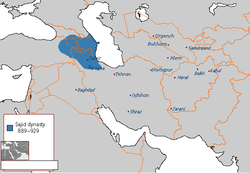Sajid dynasty
The Sajid dynasty (Persian: ساجیان), was an Iranian Muslim dynasty that ruled from 889-890 until 929. The Sajids ruled Azerbaijan and parts of Armenia first from Maragha and Barda and then from Ardabil.[lower-alpha 1][1] The Sajids originated from the Central Asian province of Ushrusana and were of Iranian (Sogdian)[2][3][lower-alpha 2] descent. Muhammad ibn Abi'l-Saj Diwdad the son of Diwdad, the first Sajid ruler of Azerbaijan, was appointed as its ruler in 889 or 890. Muhammad's father Abu'l-Saj Devdad had fought under the Ushrusanan prince Afshin Khaydar during the latter's final campaign against the rebel Babak Khorramdin in Azerbaijan, and later served the caliphs. Toward the end of the 9th century, as the central authority of the Abbasid Caliphate weakened, Muhammad was able to form a virtually independent state. Much of the Sajids' energies were spent in attempting to take control of neighboring Armenia. The dynasty ended with the death of Abu'l-Musafir al-Fath in 929.
Sajid dynasty ساجیان | |||||||||
|---|---|---|---|---|---|---|---|---|---|
| 889–929 | |||||||||
 Map of the Sajid dynasty at its greatest extent | |||||||||
| Capital | Maragha (889-901) Ardabil (901-929) | ||||||||
| Common languages | Persian | ||||||||
| Religion | Sunni Islam | ||||||||
| Government | Monarchy | ||||||||
| Afshin | |||||||||
• 889–901 | Muhammad ibn Abi'l-Saj | ||||||||
• 928–929 | Abu'l-Musafir al-Fath (last) | ||||||||
| Historical era | Middle Ages | ||||||||
• Established | 889 | ||||||||
• Disestablished | 929 | ||||||||
| |||||||||
| Today part of | |||||||||
Chronology
- Abdu Ubaydullah Muhammad Ibn Abi'l-Saj (889-901)
- Abu'l Musafir Devdad Ibn Muhammad (901)
- Yusuf Ibn Abi'l-Saj (901-919)
- Subuk (919-922) (a servant of the Sajids and a temporary care-taker)
- Yusuf (restored) (922-928)
- Fath b. Muhammad b. Abi 'l-Saj (928-929)
See also
- Sajid invasion of Georgia
- List of Sunni Muslim dynasties
- Iranian Intermezzo
Notes
- "For nearly forty years, until the killing of Fatḥ b. Moḥammad b. Abi’l-Sāj in 317/929, members of the family ruled Azerbaijan and Armenia first from Marāḡa and Barḏaʿa and then from Ardabīl. They reduced refractory Armenian princes to submission, but themselves sporadically withheld allegiance to Baghdad and suspended the payment of tribute; after the end of the Sajids, direct caliphal control was never restored in northwestern Iran."[1]
- "In ca. 279/892 the caliph Moʿtażed appointed one of his generals, Moḥammad b. Abi’l-Sāj, an Iranian from Central Asia, as governor of Azerbaijan and Armenia, and the family of the Sajids"[1]
References
- Azerbaijan IV, C.E. Bosworth, Encyclopaedia Iranica, December 15, 1987;"...the caliph Moʿtażed appointed one of his generals, Moḥammad b. Abi’l-Sāj, an Iranian from Central Asia, as governor of Azerbaijan and Armenia, and the family of the Sajids (q.v.) took their place as one of the virtually autonomous lines of provincial governors..."
- Clifford Edmund Bosworth, The New Islamic Dynasties: A Chronological and Genealogical Manual, Columbia University, 1996. pg 147: "The Sajids were a line of caliphal governors in north-western Persia, the family of a commander in the 'Abbasid service of Soghdian descent which became culturally Arabised."
- V. Minorsky, Studies in Caucasian history, Cambridge University Press, 1957. pg 111
Literature
- Madelung, Wilferd. "Minor Dynasties of Northern Iran." The Cambridge History of Iran, Volume 4: The Period From the Arab Invasion to the Saljuqs. Ed. R. N. Frye. New York, New York: Cambridge University Press, 1975.
- Clifford Edmund Bosworth, The New Islamic Dynasties: A Chronological and Genealogical Manual, Columbia University, 1996.
- V. Minorsky, Studies in Caucasian history, Cambridge University Press, 1957.
